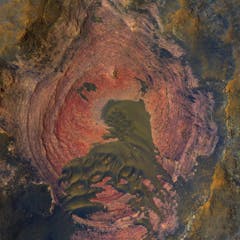
Artículos sobre NASA
Mostrando 221 - 240 de 469 artículos

It is a pretty spectacular achievement to not only rendezvous with an asteroid as it is whizzing around the Sun but also collect a sample. Here’s what the researchers learned.

Australia is a member of the 1979 Moon Treaty, which sets rules for resource extraction from outer space. Now that the Trump administration is eyeing moon mining, will Australian companies join in?

Thirty years ago the Hubble Space Telescope began snapping photos of distant stars, providing a time machine that has taken astronomers back to when the universe was less than a billion years old.

NASA scientist Katherine Johnson was instrumental in getting people to the moon. Here are some of the lessons one mathematics professor believes she taught us all.

The pioneering African-American “computer” has died aged 101.

NASA’s InSight lander has recorded the first evidence of earthquake-like tremors on Mars. The discovery opens a new chapter in our understanding of the geological processes at play on another world.

Two defunct satellites passed within metres of one another, prompting renewed focus on the dangers of space debris. But with many satellites treated as military secrets, how do we track the hazards?

By understanding how bushfire maps are created, and what their features represent, you can get better at spotting fake ones.

We pulled four before-and-after NASA satellite images and asked bushfire researcher Grant Williamson to reflect on the story they tell.

Scientists can’t expect the unexpected if they’re not open-minded about how their theories might be wrong.

Sometimes it is difficult to take a photograph of an exoplanet because the star illuminating it is too bright. Now there is a new ‘deluminator’ telescope that can block out the extra light.

Collecting samples from Mars and brining them back to Earth will be a hugely complicated task, but it may be our best bet of finding alien life.

Beyond the outer edge of the Solar System, mysterious, unknown worlds await by the thousands. Astronomers can now finally find them and explore them - but will we find another Earth?

NASA has released a sound recording from Mars. So what do these literally otherworldly sounds tell us about the processes at play inside the red planet?

A giant exomoon hundreds of times the size of Earth is revealing secrets about how giant planets like Jupiter and Saturn formed. They might also help astronomers find planets where life may thrive.

From solar sail-powered spacecraft, to laser communications, to asteroid detection systems, there is no shortage of Australian ideas and expertise to help NASA explore the Moon and Mars.

How is NASA preparing astronauts for high-stress living on the Moon? Turns out the answer is by living in undersea bases just off the coast of Florida in a lab known as Aquarius Reef Base.

It’s established Mars was once a planet with surface-level water. So with multiple MARS missions starting next year, the key to seeking out martian life may instead lie in the contents of its ‘dust’.

NASA’s Europa Clipper mission just got the green light - here’s what it could achieve.

This hot, acidic neighbor with its surface veiled in thick clouds hasn’t benefited from the attention showered on Mars and the Moon. But Venus may offer insights into the fate of the Earth.
